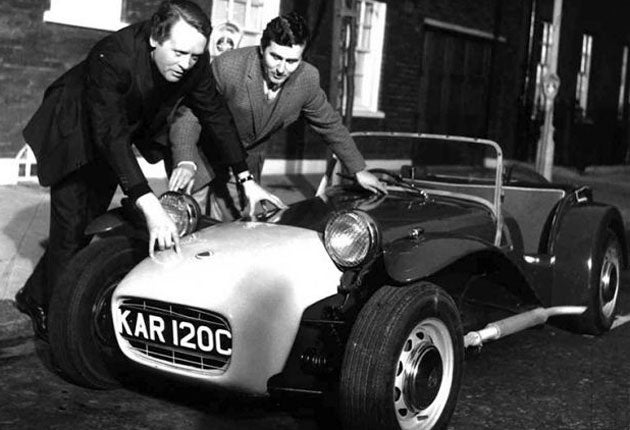Graham Nearn: Engineer and businessman behind the Caterham Seven sports car

Graham Nearn was the canny engineer and garage proprietor who acquired the rights to build the Lotus Seven sports car from Colin Chapman in 1973. The design of this skimpy two-seater dated from the mid-1950s and no longer fitted in with Chapman's ambitions as a maker of luxurious grand touring cars with higher profit margins.
Nearn, who fell in love with the Seven when he first encountered it at the Racing Car Show in 1957, recognised that there was still an appetite for the kind of raw driver-appeal this basic, lightweight sports car provided. With Chapman's blessing the Lotus Seven became the Caterham Seven, and over the next three decades Nearn turned it into one of the great success stories of an otherwise fading British motor industry with a cult following around the world. The Seven has now been in continuous production for 52 years.
Production of the Seven under Nearn's stewardship would peak at 600 cars a year in the late 1980s (with an 18-month waiting list) and in 1993 Caterham was given the Queens Award for Industry. Buyers were resistant to attempts at refining the primitive basic concept of the Seven –a closed coupe version, the Caterham 21, failed miserably – but always responded enthusiastically to bigger engines and more power to make the Seven driving experience an even more visceral thrill: the current Superlight model has a superior power-to-weight ratio to a Bugatti Veyron and goes from 0-60mph in 2.9 seconds.
Graham Bradshaw Nearn was born in Catford in south-east London and was educated at Purley Grammar School. After National Service in the Army and a spell in the timber trade he opened Caterham Car Sales on a site in Caterham, Surrey, formerly occupied by another famous name in the specialist car business, Anthony Crook of Bristol Cars. From 1959, Caterham Car Sales was the first "Lotus Centre" selling the full range of Lotus cars – but from the beginning it was the Seven that fascinated Nearn.
A direct development of Colin Chapman's first production car (the Mark 6) the Seven was conceived as a simple and inexpensive car that could be raced and used on the road as everyday transport. It was an extremely primitive road machine, in fact, with no doors, no boot, rock-hard suspension and a very basic hood. Even a fuel gauge was not part of the specification until 1968, yet enthusiasts saw all this as part of its charm as a car with uncompromised driver appeal. Nearn was proud that drivers like Graham Hill and Derek Bell had begun their racing careers in the Seven.
The cars were supplied fully built, or as kits if the owner was handy with spanners and wanted to avoid purchase tax. Engines came from humble BMC or Ford saloons but the Seven was so light that acceleration was always impressive.
In the mid-1960s, as Lotus moved up-market with the Elan, the Seven seemed doomed. Nearn persuaded the Lotus founder, Chapman, to give the Seven a reprieve when the Lotus factory moved from Cheshunt in north London to Hethel in Norfolk. From the mid-'60s Caterham Cars became the sole concessionaires for the Seven.
Nearn always believed that the Seven's weekly appearance in the opening credits of The Prisoner TV series helped its cause. Lotus had offered an Elan to the show's star and creator Patrick McGoohan, but he didn't like its associations with Emma Peel and The Avengers and preferred what he called the "maverick" appeal of the Seven. Nearn appeared briefly in the final episode of The Prisoner ("Fall-out") delivering the Seven to the home of Number Six in Buckingham Place.
In the early 1990s Nearn built a limited edition "Prisoner" Seven. He even tracked down the reclusive McGoohan for permission and persuaded him to help launch the car at the Motorshow in 1990: it was the actor's first visit to the UK since his controversial series had ended in 1968. For his trouble McGoohan was presented with one of the Prisoner Sevens – chassis number six of course.
On a limited budget Nearn was adept at keeping the Seven's profile high with regular new models offering ever more outrageous levels of acceleration. He sponsored a Caterham racing series that has become one of the most successful of its type, and kept Caterham's parts department busy. Owners spread the word about the Seven's unique fun factor, including the singer Chris Rea, who featured his much-loved Caterham of the front of his 1991 album Auberge.
Nearn's post-1973 Seven was not an immediate success: the fuel crisis and industrial problems that affected the supply of components meant that sales were slow initially and the family-run business (Nearn's wife Jane and all their children worked for Caterham at one time or another) mainly survived supplying parts and servicing existing cars. Sevens were always built to order rather than for stock, bolted together in premises where Nearn always held the freehold.
Despite expensive problems fighting copyright infringement issues with the Seven's many imitators Nearn felt able to expand the business into new premises in Dartford in 1987. Soon after he began relinquishing the day-to-day running to his son Simon, though he remained as chairman. The Nearn family sold out to a group of investors in 2005 and today Caterham, still thriving, is headed by Lotus's former general manager Ansor Ali.
Martin Buckley
Graham Bradshaw Nearn, motor engineer: born Catford, London 20 September 1933; married Jane (two sons, two daughters); died 24 October 2009.
Join our commenting forum
Join thought-provoking conversations, follow other Independent readers and see their replies
Comments